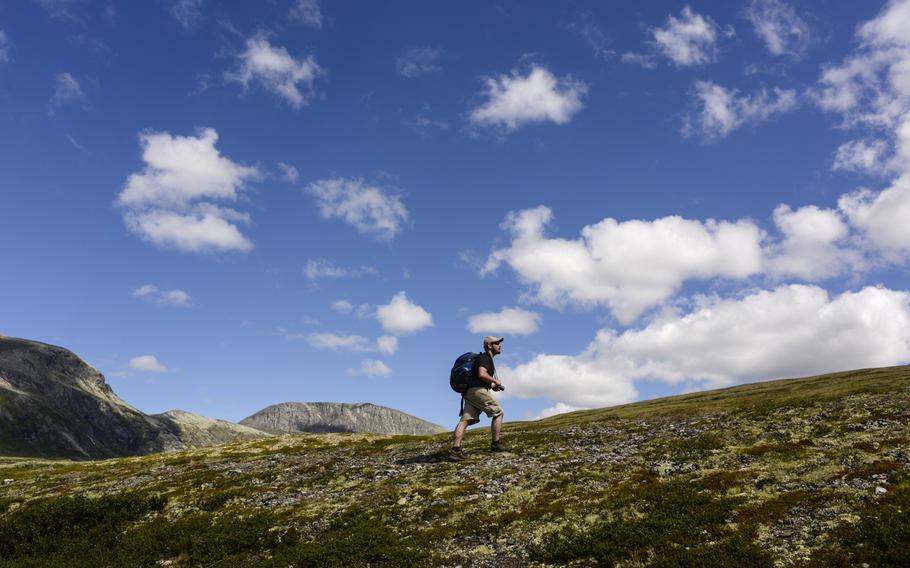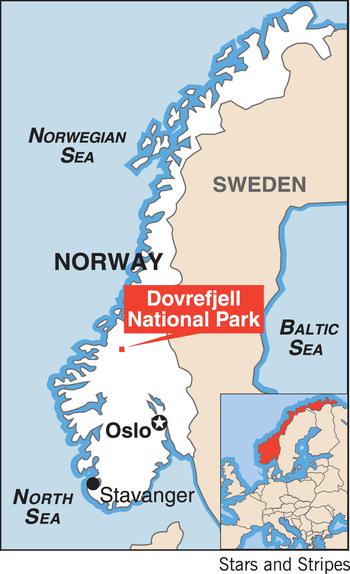
Stars and Stripes reporter Heath Druzin searches for a closer view of musk oxen in Dovrefjell National Park, Norway. (Joshua L. DeMotts/Stars and Stripes)
Up here, where even at 7 p.m. a good coat of sunscreen is crucial protection from the harsh summer glare, and prehistoric musk oxen amble over glacier-carved meadows, time is a flexible concept.
There’s no need to hit the trail early because the sun doesn’t set until … well, actually, it never really sets at all. At the height of summer, it dips and bathes the boulder-strewn mountains and scrubby high tundra in a purple glow around midnight, but it never goes far: If you have it in you, you could hike for 24 hours without fear of getting lost in the darkness.
Norway is known for its dramatic fjords and the sheer cliffs that ring the country’s iconic waterways, but farther inland and a surprisingly easy train ride from the capital, Oslo, is a lesser-known destination that provides a wilderness experience unlike any you can find on the crowded trails of mainland Western Europe.
Dovrefjell National Park is popular with Norwegian trekkers, but most foreign tourists don’t make it here, and with its seemingly endless trails, you can go hours without bumping into any living thing that doesn’t have hooves and a bad temper. One thing I love about Norwegians is that they get their kids on the trail almost as soon as they can walk (and sometimes before). The train from Oslo up to Dovrefjell was full of parents with full packs and young children in tow sporting chunky boots. Some parents even had infants in baby carriers.
I took to the trails with my reliable adventure partner, Josh DeMotts, a Stars and Stripes photographer I have nicknamed Chaco Libre for his love of scaling peaks in sandals. The appeal of Dovrefjell is threefold: challenging hiking in a wild setting, few tourists and hut-to-hut trekking that means you can pack just the essentials for a multiday journey.
The huts along the trail are simple, spotless wooden affairs stocked with everything you need for cooking, as well as an assortment of canned foods that you pay for on the honor system. Many of the huts have grass growing from the roofs and low doors, making them feel like Hobbit homes, a vibe only heightened by the landscape. It’s not a bad idea to bring a filter, but locals just pull water out of the many pristine streams flowing from the Dovrefjell Mountains that dot the park.

()
Sleep can be fitful at this latitude, with the light shimmering through cabin curtains at 3 a.m., playing havoc with your circadian rhythms. But, then again, every minute of sleep is a minute away from the dramatic landscape of Norway’s Big Sky country. And you can look at the lack of showers on the trail as a bonus: you have no excuse not to bathe in the deep green waters of an alpine lake. (I can tell you firsthand, it’s better than coffee for a jolt to wake you up).
The extensive hut system means you can cobble together a variety of treks varying in length and difficulty. You can mostly go around the park’s rugged peaks, if you want, but the brutal mountain trails are some of the highlights. Dovrefjell includes one of Norway’s most famous mountains, Snohetta (Snow Hat in Norwegian), which, for my money, more resembles a whale’s back than a hat. The climb to its 7,500-foot summit is basically one long rock scramble, and it’s the same jarring footing all the way down the other side, but the 360-degree views from the top make it well worth it. (True to form, Josh made it to the top in his Chacos, so it can’t be that bad).
If there ever were a perfect animal to fill in the vast empty spaces of this prehistoric landscape, it is the musk ox. Dovrefjell is most famous for these creatures, boasting hundreds of the shaggy, lumbering Ice Age holdovers with horns that sprout from a helmet of bone on the bisonlike beasts’ ample foreheads.
On the dusty trails that often merge without warning into hop-scotches through bogs, scrambles through boulder fields, and slips-and-slides across snowfields, it’s easy to imagine you’ve been transported back to the age of glaciers and early man whence the musk ox came.
And while the animal is protected, you can still get a taste of the beast at Kongsvold Fjeldstue, an 18th century lodge just down the road from one of the loneliest train stops in Europe. It serves as a fine jumping-off point for Dovrefjell treks and includes a surprising fine dining experience in the middle of nowhere, providing lavish multicourse meals with local ingredients.
And where do they get the musk ox meat?
“Every once in a while, one falls off a cliff,” joked Kongsvold Fjeldstue proprietor Knut Nyhus. Or maybe he wasn’t joking; he said it with that droll Norwegian delivery that always keeps me guessing.
druzin.heath@stripes.com; Twitter: @Druzin_Stripes
Dovrefjell National Park, Norway
• Getting there: There are many inexpensive flights to Oslo from around Europe. From there, it’s an easy and scenic four-hour, 45-minute train ride to Kongsvold (there are a couple other stops where you can access the park, too). Less-frequent flights go to Trondheim, by all accounts a cool college town in central Norway. From there, it’s less than two hours to the park.
• Where to stay: If you want world-class food and a step back in Norwegian history before several days of canned food on the trail, Kongsvold Fjeldstue is well worth the expense. (Hey, it’s Norway, so you’re already in for sticker shock). Prices range quite a bit depending on the accommodation, so ask them what’s available. If you don’t feel like using your feet to find the musk oxen, the lodge also offers wildlife safaris; visit www.kongsvold.no/ natur-og-turer/moskussafari.
On the trail you will be staying at lodges run by the Norwegian Trekking Association. It’s best to check in at the association’s office in Oslo, as you might need a key for some of the huts (depending on how long your trek will be, it might be worth getting a membership, which includes deep discounts on hut rates). Payment for most of the cabins is on the honor system (you can fill out a credit card form at the hut and drop it in a pay box). See http://english.turistforeningen.no.
• Information: The park is open year-round. In the winter, the trails become an endless cross-country skiing playground. The summer season is short (roughly June through August).
• Pro tip: Musk oxen are ornery creatures, so give them plenty of space. If they start snorting and you’re close enough to hear it, it’s time to back away. That’s what your zoom lens is for.